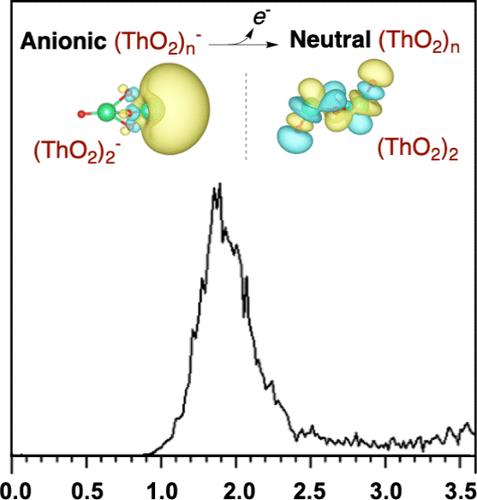Structural and Electronic Properties of Anionic (ThO2)n– (n = 2–4) Clusters
IF 4.7
2区 化学
Q1 CHEMISTRY, INORGANIC & NUCLEAR
引用次数: 0
Abstract
Thorium dioxide nanomaterials have attracted broad interest due to their catalytic properties and their possible use as fuel in next generation nuclear reactors. Investigation of their chemical and physical properties benefits from exploration of the electronic structure of small cluster units. A joint computational and experimental study is reported herein of the geometric and electronic structure of the neutral and anionic thorium dioxide clusters (ThO2)n0/–, n = 2, 3, 4. Differences were found in the identity of the global minimum structure and the distribution of structural isomers between the neutral clusters and their anionic counterparts at each size that can be traced to the nature of the highest occupied molecular orbital (HOMO). The computed vertical detachment energy (VDE) value of each cluster was in excellent agreement with the first peak of the experimental anion photoelectron spectroscopy (aPES) spectra. This spectral feature was identified as corresponding to electron ionizations from the HOMO of the global minimum structure in the (ThO2)n– (n = 2, 3, 4) clusters. To explore the origin of spectral features in the measured spectra of (ThO2)n– (n = 2, 3, 4) beyond the vertical detachment energy (VDE) peaks, a quantitative evaluation of the existing isomers was performed based on their Boltzmann distribution ratios. These fine spectral details were partially attributed to the contribution of structural isomers beyond the global minimum.

阴离子(ThO2)n - (n = 2-4)簇的结构和电子性质
二氧化钍纳米材料由于其催化性能和在下一代核反应堆中用作燃料的可能性而引起了广泛的兴趣。研究它们的化学和物理性质有利于探索小簇单位的电子结构。本文报道了中性和阴离子二氧化钍簇(ThO2)n0/ -, n = 2,3,4的几何和电子结构的计算和实验联合研究。中性团簇和阴离子团簇在不同尺寸的整体最小结构和结构异构体分布上存在差异,这可以追溯到最高占据分子轨道(HOMO)的性质。计算得到的各簇的垂直脱离能(VDE)值与实验阴离子光电子能谱(ape)的第一个峰非常吻合。该光谱特征与(ThO2)n - (n = 2,3,4)簇中全局最小结构HOMO的电子电离相对应。为了探索(ThO2)n - (n = 2,3,4)在垂直脱离能(VDE)峰之外的光谱特征的来源,根据其玻尔兹曼分布比对现有的异构体进行了定量评价。这些精细的光谱细节部分归因于结构异构体在全球最小值之外的贡献。
本文章由计算机程序翻译,如有差异,请以英文原文为准。
求助全文
约1分钟内获得全文
求助全文
来源期刊

Inorganic Chemistry
化学-无机化学与核化学
CiteScore
7.60
自引率
13.00%
发文量
1960
审稿时长
1.9 months
期刊介绍:
Inorganic Chemistry publishes fundamental studies in all phases of inorganic chemistry. Coverage includes experimental and theoretical reports on quantitative studies of structure and thermodynamics, kinetics, mechanisms of inorganic reactions, bioinorganic chemistry, and relevant aspects of organometallic chemistry, solid-state phenomena, and chemical bonding theory. Emphasis is placed on the synthesis, structure, thermodynamics, reactivity, spectroscopy, and bonding properties of significant new and known compounds.
 求助内容:
求助内容: 应助结果提醒方式:
应助结果提醒方式:


